| Seasonal changes can kill off or reduce an animal's food supply. When animals can't find food in their environment, they will move to where the food is.
Long-Distance Migrators
Some animals, especially birds and butterflies, travel incredible distances when they migrate.
Top to Bottom and Back
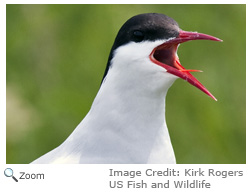 The robin-sized Arctic Tern travels 10,000 miles from pole to pole and back again every year. Each fall the Arctic Tern heads east, flies across the Atlantic Ocean, and then continues south down the coast of Europe and Africa, flying until it reaches the Antarctic Ocean. In the spring, it flies north up the coasts of South and North America until it reaches the Arctic Ocean. The robin-sized Arctic Tern travels 10,000 miles from pole to pole and back again every year. Each fall the Arctic Tern heads east, flies across the Atlantic Ocean, and then continues south down the coast of Europe and Africa, flying until it reaches the Antarctic Ocean. In the spring, it flies north up the coasts of South and North America until it reaches the Arctic Ocean.
It hardly ever rests on its trip. It is almost constantly in flight or diving to the ocean for food. Each part of the tern's trip takes about 90 days. It may spend more time in daylight than any other animal! It leaves the Arctic as the days start to get shorter in the Northern Hemisphere and travels to Antarctica as the days are getting longer in the Southern Hemisphere.
Winter in Mexico
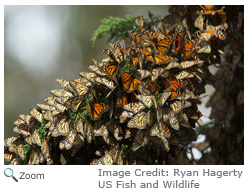 The monarch butterfly is a long distance migrator! It migrates to its breeding grounds in the spring and to its winter home in the fall. In North America, there are two large population groups that follow separate migration paths. Eastern populations of monarch butterflies winter in Texas, Florida, and Mexico. Western populations of monarchs winter along the coast of California. Monarch butterflies migrating from Canada to Mexico travel over 6,000 miles! The monarch butterfly is a long distance migrator! It migrates to its breeding grounds in the spring and to its winter home in the fall. In North America, there are two large population groups that follow separate migration paths. Eastern populations of monarch butterflies winter in Texas, Florida, and Mexico. Western populations of monarchs winter along the coast of California. Monarch butterflies migrating from Canada to Mexico travel over 6,000 miles! | |
Short-Distance Migrators
Some animals travel relatively short distances to find food or more favorable living or breeding conditions.
Down from the Mountain
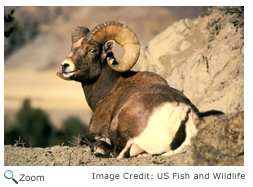 The bighorn sheep changes its home range seasonally. In warm months, it grazes on mountain slopes; in colder months, it moves down to valleys where it is easier to find food. The bighorn sheep changes its home range seasonally. In warm months, it grazes on mountain slopes; in colder months, it moves down to valleys where it is easier to find food.
To Move or Not to Move?
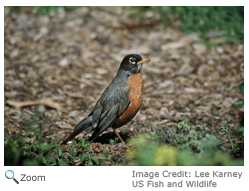 Some animals, like the American robin, may migrate or they may stay where they are, depending on where they live and how plentiful food is in the winter. Some animals, like the American robin, may migrate or they may stay where they are, depending on where they live and how plentiful food is in the winter.
Migration Hazards
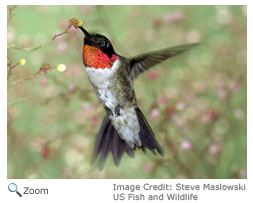 Migration can be hazardous for animals. They can face many barriers on the way to their destination. Migration can be hazardous for animals. They can face many barriers on the way to their destination.
The ruby-throated hummingbird must survive the trip from its summer breeding grounds in the eastern US and Canada to its winter range in Central America. Along the way they have to survive predators, storms, and collisions with tall buildings and TV and radio towers. Many don't survive the trip.
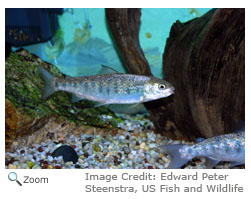 People can have an impact on migrating animals. Cutting down forests and draining wetlands for farming and development can cost animals important migratory habitats and resting places. Damming up rivers and streams can cut off migratory routes for fish. The Atlantic Salmon has to overcome obstacles like dams and waterfalls to reach its destination. People can have an impact on migrating animals. Cutting down forests and draining wetlands for farming and development can cost animals important migratory habitats and resting places. Damming up rivers and streams can cut off migratory routes for fish. The Atlantic Salmon has to overcome obstacles like dams and waterfalls to reach its destination.
Migration isn't a vacation for animals; it is a critical behavioral adaptation necessary for survival.
|






